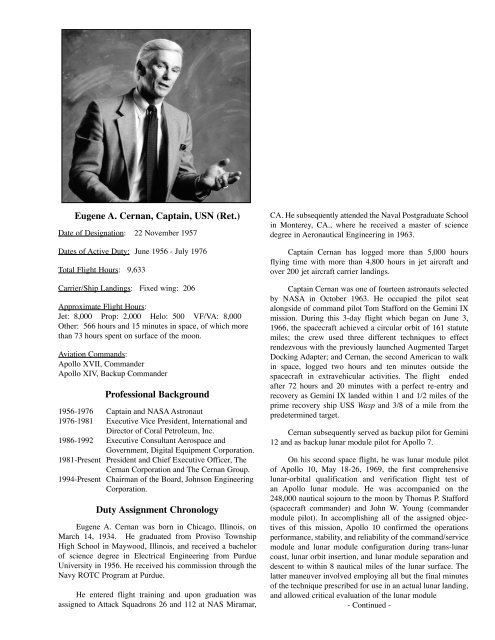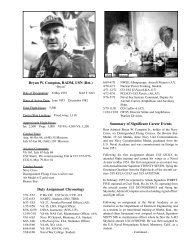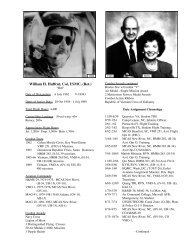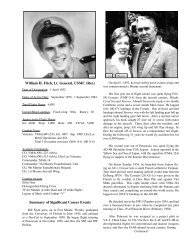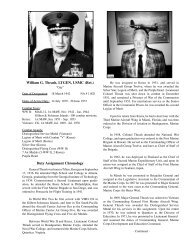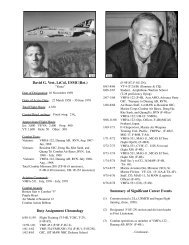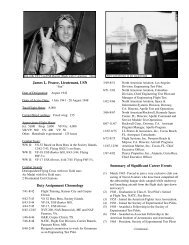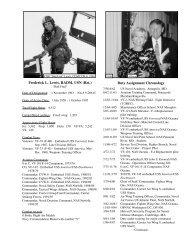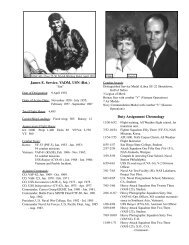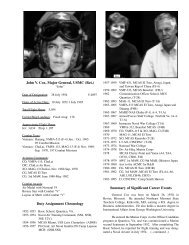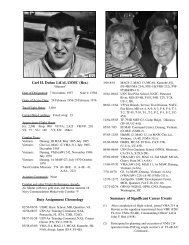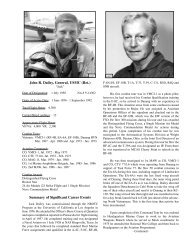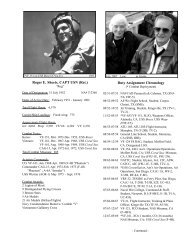Eugene A. Cernan, Captain, USN (Ret.) Professional Background ...
Eugene A. Cernan, Captain, USN (Ret.) Professional Background ...
Eugene A. Cernan, Captain, USN (Ret.) Professional Background ...
You also want an ePaper? Increase the reach of your titles
YUMPU automatically turns print PDFs into web optimized ePapers that Google loves.
<strong>Eugene</strong> A. <strong>Cernan</strong>, <strong>Captain</strong>, <strong>USN</strong> (<strong>Ret</strong>.)<br />
Date of Designation: 22 November 1957<br />
Dates of Active Duty: June 1956 - July 1976<br />
Total Flight Hours: 9,633<br />
Carrier/Ship Landings: Fixed wing: 206<br />
Approximate Flight Hours:<br />
Jet: 8,000 Prop: 2,000 Helo: 500 VF/VA: 8,000<br />
Other: 566 hours and 15 minutes in space, of which more<br />
than 73 hours spent on surface of the moon.<br />
Aviation Commands:<br />
Apollo XVII, Commander<br />
Apollo XIV, Backup Commander<br />
<strong>Professional</strong> <strong>Background</strong><br />
1956-1976 <strong>Captain</strong> and NASA Astronaut<br />
1976-1981 Executive Vice President, International and<br />
Director of Coral Petroleum, Inc.<br />
1986-1992 Executive Consultant Aerospace and<br />
Government, Digital Equipment Corporation.<br />
1981-Present President and Chief Executive Officer, The<br />
<strong>Cernan</strong> Corporation and The <strong>Cernan</strong> Group.<br />
1994-Present Chairman of the Board, Johnson Engineering<br />
Corporation.<br />
Duty Assignment Chronology<br />
<strong>Eugene</strong> A. <strong>Cernan</strong> was born in Chicago, Illinois, on<br />
March 14, 1934. He graduated from Proviso Township<br />
High School in Maywood, Illinois, and received a bachelor<br />
of science degree in Electrical Engineering from Purdue<br />
University in 1956. He received his commission through the<br />
Navy ROTC Program at Purdue.<br />
He entered flight training and upon graduation was<br />
assigned to Attack Squadrons 26 and 112 at NAS Miramar,<br />
CA. He subsequently attended the Naval Postgraduate School<br />
in Monterey, CA., where he received a master of science<br />
degree in Aeronautical Engineering in 1963.<br />
<strong>Captain</strong> <strong>Cernan</strong> has logged more than 5,000 hours<br />
flying time with more than 4,800 hours in jet aircraft and<br />
over 200 jet aircraft carrier landings.<br />
<strong>Captain</strong> <strong>Cernan</strong> was one of fourteen astronauts selected<br />
by NASA in October 1963. He occupied the pilot seat<br />
alongside of command pilot Tom Stafford on the Gemini IX<br />
mission. During this 3-day flight which began on June 3,<br />
1966, the spacecraft achieved a circular orbit of 161 statute<br />
miles; the crew used three different techniques to effect<br />
rendezvous with the previously launched Augmented Target<br />
Docking Adapter; and <strong>Cernan</strong>, the second American to walk<br />
in space, logged two hours and ten minutes outside the<br />
spacecraft in extravehicular activities. The flight ended<br />
after 72 hours and 20 minutes with a perfect re-entry and<br />
recovery as Gemini IX landed within 1 and 1/2 miles of the<br />
prime recovery ship USS Wasp and 3/8 of a mile from the<br />
predetermined target.<br />
<strong>Cernan</strong> subsequently served as backup pilot for Gemini<br />
12 and as backup lunar module pilot for Apollo 7.<br />
On his second space flight, he was lunar module pilot<br />
of Apollo 10, May 18-26, 1969, the first comprehensive<br />
lunar-orbital qualification and verification flight test of<br />
an Apollo lunar module. He was accompanied on the<br />
248,000 nautical sojourn to the moon by Thomas P. Stafford<br />
(spacecraft commander) and John W. Young (commander<br />
module pilot). In accomplishing all of the assigned objectives<br />
of this mission, Apollo 10 confirmed the operations<br />
performance, stability, and reliability of the command/service<br />
module and lunar module configuration during trans-lunar<br />
coast, lunar orbit insertion, and lunar module separation and<br />
descent to within 8 nautical miles of the lunar surface. The<br />
latter maneuver involved employing all but the final minutes<br />
of the technique prescribed for use in an actual lunar landing,<br />
and allowed critical evaluation of the lunar module<br />
- Continued -
Duty Assignment Chronology continued<br />
propulsions systems and rendezvous of the landing radar<br />
devices in subsequent rendezvous and re-docking maneuvers.<br />
In addition to demonstrating that man could navigate safely<br />
and accurately in the moon's gravitational fields, Apollo 10<br />
photographed and mapped tentative landing sites for future<br />
lunar missions.<br />
<strong>Cernan</strong>'s next assignment was backup spacecraft commander<br />
for Apollo 14.<br />
He made his third space flight as spacecraft commander<br />
of Apollo 17--the last scheduled manned mission to the<br />
moon for the United States--which commenced at 11:33 P.M.<br />
(CST), December 6, 1972, with the first manned nighttime<br />
launch, and concluded on December 19, 1972. With him on<br />
the voyage of the command module "America" and the lunar<br />
module "Challenger” were Ronald Evans (command module<br />
pilot) and Harrison H. (Jack) Schmitt (lunar module pilot).<br />
In maneuvering "Challenger" to a landing at Taurus-Littrow,<br />
located on the located on the southeast edge of Mare<br />
Serenitatis, <strong>Cernan</strong> and Schmitt activated a base of operation<br />
from which they completed three highly successful excursions<br />
to the nearby craters and the Taurus mountains, making<br />
the Moon their home for over three days. This last mission<br />
to the moon established several new records for manned<br />
space flight that include: longest manned lunar landing flight<br />
(301 hours 51 minutes); longest lunar surface extravehicular<br />
activities (22 hours 6 minutes); largest lunar sample return<br />
(an estimated 115 kg (249 lbs.)); and longest time in lunar<br />
orbit (147 hours 48 minutes). Apollo 17 ended with a<br />
splashdown in the Pacific Ocean approximately 0.4 miles<br />
from the target point and 4.3 miles from the prime recovery<br />
ship USS Ticonderoga.<br />
In September, 1973, <strong>Cernan</strong> assumed additional duties<br />
as Special Assistant to the Program Manager of the Apollo<br />
spacecraft Program at the Johnson Space Center.. In this<br />
capacity, he assisted in the planning, development, and<br />
evaluation of the joint United States/Soviet Union Apollo-<br />
Soyuz mission, and he acted for the program manager as the<br />
senior U. S. negotiator in direct discussions with the USSR<br />
on the Apollo-Soyuz Test Project.<br />
On July 1, 1976, <strong>Captain</strong> <strong>Cernan</strong> retired after over<br />
20 years with the U. S. Navy. He concurrently terminated<br />
his formal association with NASA. <strong>Cernan</strong> joined Coral<br />
Petroleum, Inc., of Houston, Texas, as Executive Vice<br />
President-International. His responsibilities were to enhance<br />
Coral's energy related programs on a worldwide basis.<br />
In September 1981, <strong>Captain</strong> <strong>Cernan</strong> started his own<br />
company, The <strong>Cernan</strong> Corporation, to pursue management<br />
and consultant interests in the energy, aerospace, and other<br />
related industries. Additionally he has been actively involved<br />
as a co-anchorman on ABC-TV's presentation of the flight<br />
of the shuttle.<br />
In 1994, <strong>Captain</strong> <strong>Cernan</strong> became Chairman of the Board<br />
of Johnson Engineering Corporation. Johnson Engineering<br />
currently provides the National Aeronautics and. Space<br />
Administration with Flight Crew Systems Development<br />
with personnel located both on and off site at Johnson Space<br />
center. Over the last seventeen years, Johnson Engineering<br />
has supported NASA in the design of crew stations for Space<br />
Shuttle, Spacelab, Space Station, Lunar Base and Mars<br />
Outpost. The company is directly involved with the operation<br />
of the 1-G trainers in Building 9A and B, as well as the<br />
Weightless Environment Training Facility in Building 29.<br />
<strong>Captain</strong> <strong>Cernan</strong> was the second American to have<br />
walked in space, having spanned the circumference of the<br />
world twice in a little more than 2 l/2 hours. He served as<br />
commander of the last mission to the moon, Apollo 17, and<br />
had the privilege and distinction of being the last man to<br />
have left his footprints on the surface the moon.<br />
Summary of Significant Career Events<br />
(1) <strong>Captain</strong> Gene <strong>Cernan</strong> was the pilot on the Gemini IX<br />
mission and the second American to walk in space.<br />
(2) He was lunar module pilot of Apollo X, and Spacecraft<br />
Commander of Apollo XVII, which resulted in the distinction<br />
of being the last man to have left his footprints<br />
on the surface of the moon.<br />
(3) Logged 566 hours and 15 minutes in space-of which<br />
more then 73 hours were spent on the surface of the<br />
moon. Was one of the two men to have flown to the<br />
moon on two occasions.<br />
(4) Honorary Doctorates of Engineering from Purdue,<br />
Drexel and Gonzaga Universities, and an Honorary<br />
Doctorate degree from Western State College of Law<br />
and Comenius University of the Slovak Republic.<br />
Family<br />
Married to Jan Nanna <strong>Cernan</strong>. Have three daughters: Teresa<br />
<strong>Cernan</strong> Woolie, Kelly Nanna Taff and Danielle Nanna Ellis.<br />
Special Honors<br />
4 Distinguished Service Medals (2 Navy and 2 NASA).<br />
NASA Exceptional Service Medal.<br />
JSC Superior Achievement Award.<br />
Distinguished Flying Cross (Navy).<br />
National Academy of Television Arts and Sciences Special<br />
Trustees Award (1969).<br />
Federation Aeronautique Internationale Gold Space Medal<br />
(1972).<br />
VFW National Space Medal (1973)<br />
Inducted into the U. S. Space Hall of Fame.<br />
Olympic Torch Bearer (May 1996)


